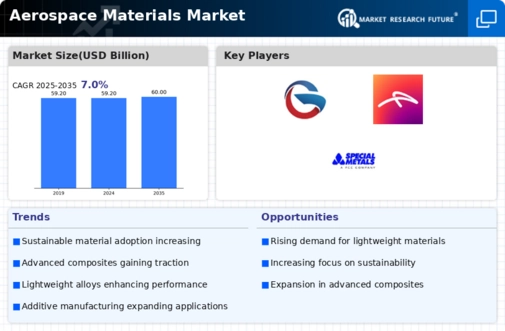-
Executive Summary
-
Scope of the Report
-
Market Definition
-
Scope of the Study
-
List of Assumptions
-
Markets Structure
-
Market Research Methodology
-
Research
-
Process
-
Primary Research
-
Secondary Research
-
Market Size
-
Estimation
-
Forecast Model
-
Market Factor Analysis
-
Supply
- Raw Material Suppliers
- Manufacturers/Producers
- Distributors/Retailers/Wholesalers/E-Commerce
- End-Use Industries/Material Type
-
Chain Analysis
-
of Aerospace Materials
-
Merchants
-
Porter’s Five
- Threat of New Entrants
- Intensity of Competitive
- Threat of Substitutes
- Bargaining Power of Suppliers
- Bargaining Power of Buyers
-
Forces Model
-
Rivalry
-
Pricing Analysis
-
Market
-
Dynamics of Global Aerospace Materials Market
-
Introduction
-
Drivers
-
Restraints
-
Opportunities
-
Challenges
-
Global
-
Aerospace Materials Market, by Material Type
-
Introduction
-
Composite
- Market Estimates & Forecast, 2020–2027
- Market Estimates
-
& Forecast, by Region, 2020–2027
-
Steel
- Market Estimates
- Market Estimates & Forecast, by Region,
-
& Forecast, 2020–2027
-
Titanium
- Market Estimates & Forecast, 2020–2027
- Market Estimates & Forecast, by Region, 2020–2027
-
Aluminum
- Market Estimates & Forecast, 2020–2027
- Market Estimates
-
& Forecast, by Region, 2020–2027
-
Others
- Market Estimates
- Market Estimates & Forecast, by Region,
-
& Forecast, 2020–2027
-
Global Aerospace Materials Market, by Aircraft Type
-
Introduction
-
Civil Aircraft
- Market Estimates & Forecast,
- Market Estimates & Forecast, by Region, 2020–2027
-
Military Aircraft
- Market Estimates & Forecast, 2020–2027
- Market Estimates & Forecast, by Region, 2020–2027
-
Others
- Market Estimates & Forecast, 2020–2027
- Market Estimates
-
& Forecast, by Region, 2020–2027
-
Global Aerospace Materials Market,
-
by Region
-
Introduction
-
North America
- Market Estimates
- Market Estimates & Forecast, by Material
- Market Estimates & Forecast, by Aircraft Type,
- US
- Canada
-
& Forecast, 2020–2027
-
Type, 2020–2027
-
Europe
- Market Estimates & Forecast, 2020–2027
-
Market Estimates & Forecast, by Material Type, 2020–2027
-
Estimates & Forecast, by Aircraft Type, 2020–2027
-
& Forecast, by Material Type, 2020–2027
-
& Forecast, by Aircraft Type, 2020–2027
-
Market Estimates & Forecast, 2020–2027
-
Forecast, by Material Type, 2020–2027
-
Forecast, by Aircraft Type, 2020–2027
-
Estimates & Forecast, 2020–2027
-
by Material Type, 2020–2027
-
by Aircraft Type, 2020–2027
-
& Forecast, 2020–2027
-
Material Type, 2020–2027
-
Aircraft Type, 2020–2027
-
Forecast, 2020–2027
-
Type, 2020–2027
-
Type, 2020–2027
-
China
-
Market
-
Germany
-
Market Estimates & Forecast, 2020–2027
-
Market Estimates
-
Market Estimates
-
France
-
Market Estimates &
-
Market Estimates &
-
Italy
-
Market
-
Market Estimates & Forecast,
-
Market Estimates & Forecast,
-
Spain
-
Market Estimates
-
Market Estimates & Forecast, by
-
Market Estimates & Forecast, by
-
UK
-
Market Estimates &
-
Market Estimates & Forecast, by Material
-
Market Estimates & Forecast, by Aircraft
-
Russia
-
Market Estimates & Forecast,
-
Market Estimates & Forecast, by Material Type,
-
Market Estimates & Forecast, by Aircraft Type,
-
Poland
-
Market Estimates & Forecast,
-
Market Estimates & Forecast, by Material Type,
-
Market Estimates & Forecast, by Aircraft Type,
-
Asia-Pacific
- Market Estimates & Forecast,
- Market Estimates & Forecast, by Material Type, 2020–2027
- Market Estimates & Forecast, by Aircraft Type, 2020–2027
-
Market Estimates & Forecast, by Material Type, 2020–2027
-
Market Estimates & Forecast, by Aircraft Type, 2020–2027
-
& Forecast, by Material Type, 2020–2027
-
& Forecast, by Aircraft Type, 2020–2027
-
Market Estimates & Forecast, 2020–2027
-
Forecast, by Material Type, 2020–2027
-
Forecast, by Aircraft Type, 2020–2027
-
Estimates & Forecast, 2020–2027
-
by Material Type, 2020–2027
-
by Aircraft Type, 2020–2027
-
& Forecast, 2020–2027
-
Material Type, 2020–2027
-
Aircraft Type, 2020–2027
-
Estimates & Forecast, 2020–2027
-
by Material Type, 2020–2027
-
by Aircraft Type, 2020–2027
-
Market Estimates & Forecast, 2020–2027
-
Forecast, by Material Type, 2020–2027
-
by Aircraft Type, 2020–2027
-
& Forecast, 2020–2027
-
Material Type, 2020–2027
-
Aircraft Type, 2020–2027
-
& Forecast, 2020–2027
-
Material Type, 2020–2027
-
Aircraft Type, 2020–2027
-
& Forecast, 2020–2027
-
Material Type, 2020–2027
-
Aircraft Type, 2020–2027
-
Forecast, 2020–2027
-
Type, 2020–2027
-
Type, 2020–2027
-
Market Estimates & Forecast, 2020–2027
-
Forecast, by Material Type, 2020–2027
-
Forecast, by Aircraft Type, 2020–2027
-
Estimates & Forecast, 2020–2027
-
by Material Type, 2020–2027
-
Aircraft Type, 2020–2027
-
& Forecast, 2020–2027
-
Material Type, 2020–2027
-
Aircraft Type, 2020–2027
-
& Forecast, 2020–2027
-
Material Type, 2020–2027
-
Aircraft Type, 2020–2027
-
& Forecast, 2020–2027
-
Material Type, 2020–2027
-
Aircraft Type, 2020–2027
-
Estimates & Forecast, 2020–2027
-
by Material Type, 2020–2027
-
by Aircraft Type, 2020–2027
-
India
-
Market Estimates & Forecast, 2020–2027
-
Market Estimates
-
Market Estimates
-
Japan
-
Market Estimates &
-
Market Estimates &
-
Australia
-
Market
-
Market Estimates & Forecast,
-
Market Estimates & Forecast,
-
New Zealand
-
Market Estimates
-
Market Estimates & Forecast, by
-
Market Estimates & Forecast, by
-
Rest of Asia-Pacific
-
Market
-
Market Estimates & Forecast,
-
Market Estimates & Forecast,
-
Middle East & Africa
- Market Estimates &
- Market Estimates & Forecast,
- Turkey
- Israel
- South Africa
- GCC
- Rest of the Middle East & Africa
-
Latin America
- Market
- Market Estimates & Forecast,
- Market Estimates & Forecast, by
- Brazil
- Argentina
- Mexico
- Rest of Latin America
-
Competitive Landscape
-
Introduction
-
Market Key Strategies
-
Key Development Analysis
-
(Expansions/Mergers
-
& Acquisitions/Joint Ventures/New Product Developments/Agreements/Investments)
-
Company Profiles
-
Vitamin C60 BioResearch Corporation
- Financial Overview
- Products Offered
- Key Developments
- SWOT Analysis
- Key Strategies
-
Company Overview
-
Nano-C
- Company Overview
- Financial Overview
- Key Developments
- SWOT Analysis
-
Products Offered
-
Key Strategies
-
Frontier Carbon Corporation
- Company Overview
- Financial Overview
- Products Offered
- Key Developments
- SWOT Analysis
- Key Strategies
-
Solenne BV
- Financial Overview
- Products Offered
- Key Developments
- SWOT Analysis
- Key Strategies
-
Company Overview
-
MTR Ltd
- Company Overview
- Financial Overview
- Key Developments
- SWOT Analysis
-
Products Offered
-
Key Strategies
-
BuckyUSA
- Company Overview
- Financial
- Products Offered
- Key Developments
- SWOT
- Key Strategies
-
Overview
-
Analysis
-
American Elements
- Company
- Financial Overview
- Products Offered
- SWOT Analysis
- Key Strategies
- Company Overview
- Products Offered
- Key Developments
- SWOT Analysis
- Key Strategies
-
Overview
-
Key Developments
-
Nanostructured & Amorphous Materials, Inc
-
Financial Overview
-
NeoTechProduct
- Financial Overview
- Products Offered
- Key Developments
- SWOT Analysis
- Key Strategies
-
Company Overview
-
Xiamen Funano New Material Technology Company LTD
- Company Overview
- Financial Overview
- Products Offered
- Key Developments
- SWOT Analysis
- Key Strategies
-
Merck KGaA
- Financial Overview
- Products Offered
- Key Developments
- SWOT Analysis
- Key Strategies
-
Company Overview
-
Appendix
-
-
LIST OF TABLES
-
Global Aerospace Materials
-
Market, by Region, 2020–2027
-
North America: Aerospace Materials
-
Market, by Country, 2020–2027
-
Europe: Aerospace Materials Market,
-
by Country, 2020–2027
-
Asia-Pacific: Aerospace Materials Market,
-
by Country, 2020–2027
-
Middle East & Africa: Aerospace Materials
-
Market, by Country, 2020–2027
-
Latin America: Aerospace Materials
-
Market, by Country, 2020–2027
-
Global Aerospace Materials Material
-
Type Market, by Region, 2020–2027
-
North America: Aerospace Materials
-
Material Type Market, by Country, 2020–2027
-
Europe: Aerospace
-
Materials Material Type Market, by Country, 2020–2027
-
Asia-Pacific:
-
Aerospace Materials Material Type Market, by Country, 2020–2027
-
Table
-
Middle East & Africa: Aerospace Materials Material Type Market, by Country,
-
Latin America: Aerospace Materials Material Type
-
Market, by Country, 2020–2027
-
Global Aerospace Materials Aircraft
-
Type Market, by Region, 2020–2027
-
North America: Aerospace
-
Materials Aircraft Type Market, by Country, 2020–2027
-
Europe:
-
Aerospace Materials Aircraft Type Market, by Country, 2020–2027
-
Table
-
Asia-Pacific: Aerospace Materials Aircraft Type Market, by Country, 2020–2027
-
Middle East & Africa: Aerospace Materials Aircraft Type Market,
-
by Country, 2020–2027
-
Latin America: Aerospace Materials Aircraft
-
Type Market, by Country, 2020–2027
-
Global Material Type Market,
-
by Region, 2020–2027
-
Global Aircraft Type Market, by Region,
-
North America: Aerospace Materials Market, by Country,
-
North America: Aerospace Materials Market, by Material
-
Type, 2020–2027
-
North America: Aerospace Materials Market, by
-
Aircraft Type, 2020–2027
-
Europe: Aerospace Materials Market,
-
by Country, 2020–2027
-
Europe: Aerospace Materials Market, by
-
Material Type, 2020–2027
-
Europe: Aerospace Materials Market,
-
by Aircraft Type, 2020–2027
-
Asia-Pacific: Aerospace Materials
-
Market, by Country, 2020–2027
-
Asia-Pacific: Aerospace Materials
-
Market, by Material Type, 2020–2027
-
Asia-Pacific: Aerospace
-
Materials Market, by Aircraft Type, 2020–2027
-
Middle East &
-
Africa: Aerospace Materials Market, by Country, 2020–2027
-
Middle
-
East & Africa: Aerospace Materials Market, by Material Type, 2020–2027
-
Middle East & Africa: Aerospace Materials Market, by Aircraft Type,
-
Latin America: Aerospace Materials Market, by Country,
-
Latin America: Aerospace Materials Market, by Material
-
Type, 2020–2027
-
Latin America: Aerospace Materials Market, by
-
Aircraft Type, 2020–2027
-
LIST OF FIGURES
-
Global Aerospace
-
Materials Market Segmentation
-
Forecast Research Methodology
-
FIGURE
-
Porter’s Five Forces Analysis of Global Aerospace Materials Market
-
FIGURE
-
Value Chain/Supply Chain of Global Aerospace Materials Market
-
Share
-
of Global Aerospace Materials Market, by Country, 2020 (%)
-
Global
-
Aerospace Materials Market, 2020–2027
-
Global Aerospace Materials
-
Market Size, by Material Type, 2020 (%)
-
Share of Global Aerospace
-
Materials Market, by Material Type, 2020–2027
-
Global Aerospace
-
Materials Market Size, by Aircraft Type, 2020 (%)
-
Share of Global
-
Aerospace Materials Market, by Aircraft Type, 2020–2027

















Leave a Comment